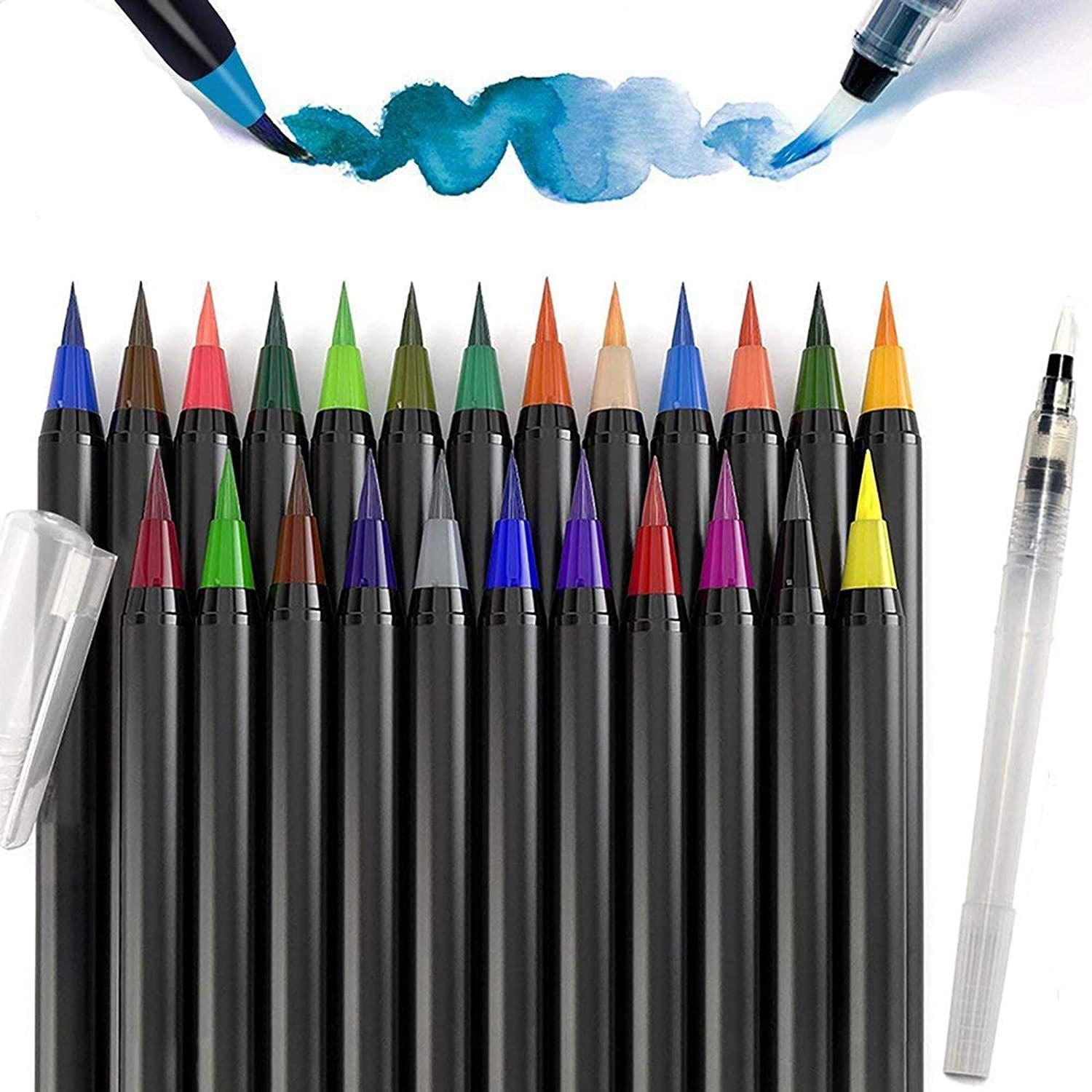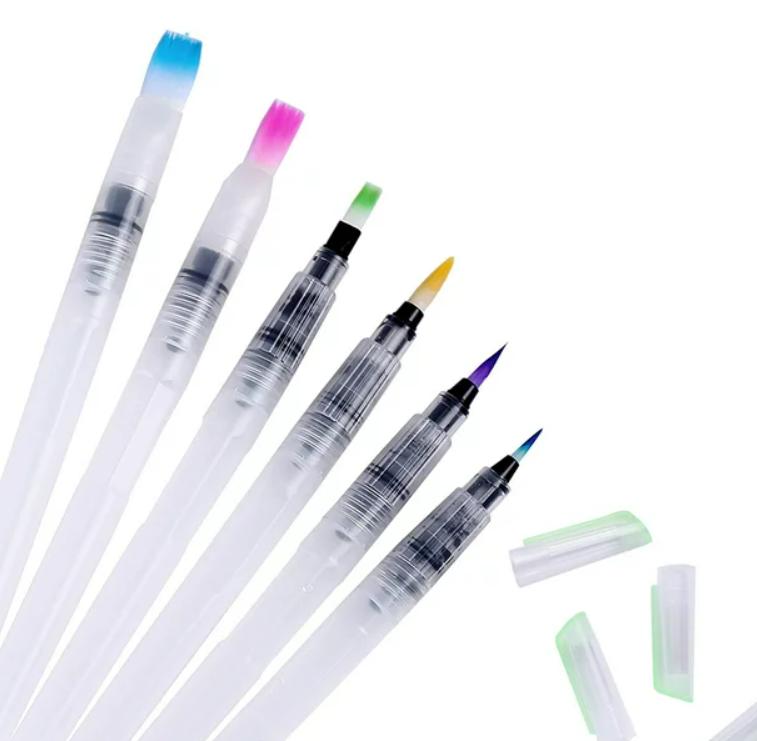Watercolor brush pens will be an excellent addition to your art supplies if you like painting, coloring, or drawing. These pens come with smooth brush tips and vibrant colors and offer great control and precision and allow you to create the effects of regular watercolor.
You can use these versatile water brush pens to use different techniques and create different patterns and textures, which aren’t possible with traditional markets, like soft ombre effects, gradients, color washes, and dreamy blending. These pens can also be used for adult coloring books.
So, if you are planning to start a new coloring journey, consider reading this guide to learn the best ways to use watercolor brush pens to spark your inner artist.

What Exactly Are Watercolor Brush Pens?
If you have ever worked with typical watercolors, you’d already know how messy they are. You need to arrange different types of brushes, tubes, and water to set up your workspace.
A water brush pen has dye-based and water-soluble ink that allows you to create interesting effects with different strokes and styles by adding water. The small form factor also makes these pens portable so that you can carry them on the go.
Watercolor brush pens come with all the characteristics of watercolors and eliminate the need for additional supplies. They have versatile and flexible brush tips that can be used for hand lettering and modern calligraphy.
On top of that, you don’t need to use a traditional brush. It means you can make curved and short strokes just like traditional watercolor painting, whether you want to create floral designs or to create textures and patterns.
How to Use Watercolor Pens?
Essentially, you only need watercolor pens and watercolor paper to start working with watercolor pens. The rest of the supplies such as an eraser and graphite pencil are optional. A pencil allows you to create a rough sketch before putting a brush pen on your paper.
Additionally, a clear water pen will also come in handy to blend different colors. It comes with an empty container to hold water and they also have a small pointed brush.
Supplies You’ll Need
Watercolor Brush Pens
Different brands offer different types of watercolor brush pens and you can buy them from your local art supply store. Consider brush tip type, the number of colors you need, and your budget while buying a set of watercolor brush pens.
I recommend you buy watercolor pens that come with dual nibs. The wider tip will allow you to make broad strokes and the pointed one will help you achieve fine details.
Watercolor Paper
Using ordinary printer paper is not recommended because the water-based ink will eat through it. Therefore, you should buy smooth, thick, and high-quality watercolor paper so that it can withstand your watercolor brush pens.
Considering the texture is also important when buying watercolor paper. If you’re a beginner, consider going with cold press paper that comes with a rough texture and provides you with better control over the ink spread. But you need to keep in mind that your pen brushes will wear out quickly.
You can buy hot press paper if you are confident that you can control color bleed. These thick pages are smoother and slicker than cold press paper and suit professionals better.
Note: Watercolor brush pens can work on both dry and wet paper and can be used in a coloring book.
Ways to Use Watercolor Brush Pens

Get to Know Your Colors
The first step is to understand the basics that start by getting to know what you’re working with, just like any other creative venture. I recommend you create a separate color guide by using each pen and drawing a small square or any other shape.
Store this chart safely to use it as a point of reference and it’ll help you understand how each color will appear on your drawing paper. You can also set aside the watercolor pens that you will be using the most if you like to keep your supplies organized.
Understand the Basics
Fill your clear water pen with water and use it on the half square before the ink dries out. Now move your clear water pen to complete the square. Using a clear water pen comes in handy if you want to create a lighter shade of the watercolor brush pen that you used on the paper.
Layering
Select two colors of the same family and use the lighter one to make the outline of the shape you want to make and let it dry. Use the darker color to outline a portion of the shape and use the clear water pen to merge the two colors.
This way you can add shading and depth by making new shades. Consider playing around to figure out the different pairs of colors that work the best with each other.
You’ll need to use the brush nib of watercolor pens to alternate between thick and thin lines. Using downstrokes and upstrokes will allow you to change the effect of the final results. Try as many different types of brush strokes as possible with different directions and amounts of pressure.
It’ll allow you to pick up the right watercolor pen and apply just the right amount of pressure in the required direction to achieve the best results.
Blending
One of the best things about watercolor pens is that you can blend them easily. I have already discussed the method of layering with a clear water pen that you can use for this purpose. Other than that, you can also dip one of the two pens in water use in the place where the two colors meet to create a gradient.
Ombre Effect
Creating an ombre effect is also possible with watercolor brush pens. Take two colors of the same family and place the tip of the darker color on the tip of the lighter color for a few seconds. You can also rub the tips of the two pens gently to mix colors.
Make sure to apply a darker color to the lighter one and not the other way around. It’ll allow you to carefully observe the amount of color being transferred. Once your lighter pen has absorbed the darker shade, use it as usual to create an ombre effect.
Note: Make sure that you clean the tips of your used watercolor brush pens after creating the ombre effect. Just dip the tip of your pens in water and use them on a spare piece of paper for a few seconds. It’ll allow your pens to regain their original and intended color.
Floral Designs
You can also create floral designs using watercolor brush pens. Choose your desired color and make a small dot right in the center of your watercolor paper. Surround the dot with a few curved strokes using the same pen and applying more pressure.
Now use the same pen by applying very light pressure to color the inner sides of the curved strokes to create a petals-like effect. Start increasing the pressure as you move toward the center to create a gradient.
Hand-Lettering
Watercolor pens allow you to make calligraphy and hand-lettering projects. The following are the most important points while creating letters using watercolor brush pens.
Use only the tip of the pen and apply light pressure while making upward strokes.
Place the pen on the paper with a small angle and increase the pressure so that you can make wider downward strokes.
This way, you can easily create a shadow effect and depth to your letters by darkening the bottom parts of your downward strokes.
Experiment with Different Colors and Techniques
You can play around with different watercolor pens and techniques to create new shades. From bold and broad to intricate and thin, you can perform all types of strokes. You can easily blend colors by simply adding a drop of water to your page to create new hues.
You can also create a completely different color by mixing together two colors as well. Plus, only one pen allows you to achieve different gradients by varying the amount of applied pressure as these colored pens are highly saturated. There are limitless possibilities just like your imagination.
Benefits of Water Colour Brush Pens
-
Watercolor brush pens are easy to set up and highly portable.
-
You only need to open your watercolor pen set and you’ll be ready to paint.
-
Unlike traditional watercolors, you don’t need any brush to constantly dip in water and paint.
-
You don’t need to keep a lot of brushes to switch between while painting to achieve different brush strokes.
-
There is no need to maintain a table full of palettes and tubes.
-
Storing your watercolor brush paint is a breeze as you just need to pop the lids back and place them on their designated spot.
Watercolor Brush Pens Vs Watercolor Paints

The biggest difference between traditional watercolor paints and watercolor brush pens is that you don’t need to dip your pens into paint and water continuously. A watercolor brush pen comes with a built-in cartridge which means it’s always loaded with color to paint.
Adjusting the amount of pressure applied to your watercolor pen allows you to transition from broad strokes to thin lines smoothly which is not possible with watercolor paints and brushes.
If you don’t have water available or just don’t want to use it, you can still paint with your watercolor brush pens. Water is optional but it allows you to achieve even lighter gradients and create beautiful watercolor effects. On the other hand, you can’t use watercolor paint without water.
Watercolor painting needs a considerable amount of time to dry. On the other hand, the paint dries a lot faster with watercolor pens. This feature comes in handy if you need to apply several layers. Not only will you achieve more consistent color results but you’ll also have a finished piece in a short time.
FAQs
Are Watercolor Brush Pens Good for Beginners?
Yes, watercolor pens are one of the best mediums for beginners to learn new techniques and improve their drawing and painting skills. They are easier to use than other watercolor mediums. You can also use them along with watercolor paints, watercolor pencils, and even non-watercolor supplies such as simple colored pencils, charcoal, and ink. So, regardless of the medium you currently use, you can buy watercolor markers to diversify your creativity toolkit.
How Do You Clean Watercolor Brush Pens?
Since a watercolor brush pen is essentially a marker, you don’t need to use any special technique to clean it. All you need to do is to dip your pen tips in water for a couple of seconds and clean them using a paper towel. If you have not touched the brush tip of your pen to any other color, you don’t even need to perform this step.
How to Keep Watercolor Brush Pens in a Good Condition?
Once you’re done painting, make sure that you cap each pen tightly before storing them to keep your pens in a good condition. Ideally, you should place your watercolor pens in a cool and dry place to keep their ink from drying.
Conclusion
Watercolor pens/markers are one of the best and easiest art mediums and you can use them for all types of projects such as sketching and illustrating, hand-lettering, outdoor painting, and more. They can be a little tricky at first but using the right materials and following the right techniques mentioned in this guide will allow you to create masterpieces.
Make sure that you buy a high-quality brush pen set and practice as much as possible to polish your drawing and painting skills. I hope the methods and techniques discussed in this guide will help you kick-start your coloring journey.
Happy Creating.



